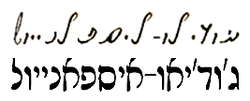In linguistic typology, nominative–accusative alignment is a type of morphosyntactic alignment in which subjects of intransitive verbs are treated like...
20 KB (2,151 words) - 09:25, 15 March 2025
nominative alignment is an unusual type of morphosyntactic alignment similar to, and often considered a subtype of, a nominative–accusative alignment...
6 KB (695 words) - 09:23, 15 March 2025
those to the latter. The ergative-absolutive alignment is in contrast to nominative–accusative alignment, which is observed in English and most other...
48 KB (4,587 words) - 23:03, 8 June 2025
both or none of them.[further explanation needed] Nominative–accusative (or accusative) alignment treats the S argument of an intransitive verb like...
20 KB (2,389 words) - 13:37, 27 April 2025
clause, is in the nominative case ("She wrote a book"); but if the pronoun is instead the object of the verb, it is in the accusative case and she becomes...
17 KB (1,970 words) - 18:52, 25 May 2025
system of a language. This is in contrast with nominative-accusative and ergative-absolutive alignment languages, in which the argument of an intransitive...
13 KB (1,348 words) - 05:11, 18 June 2025
is marked, the other two roles are not – that is, a typical nominative–accusative alignment. Intransitive: no case marking az-um I(ABS)-1SG pa to Xaraɣ...
3 KB (450 words) - 23:45, 20 September 2023
usually nominative–accusative. The conditions in which ergative constructions are used vary among different languages. Nominative–accusative languages...
12 KB (1,663 words) - 13:57, 27 March 2025
Labile verb Morphosyntactic alignment Nominative-absolutive language (Marked nominative alignment) Nominative-accusative language Unaccusative verb Unergative...
23 KB (2,618 words) - 23:00, 8 June 2025
Grammatical case (section Morphosyntactic alignment)
the nominative pronouns I/they represent the perceiver, and the accusative pronouns me/them represent the phenomenon perceived. Here, nominative and accusative...
77 KB (7,080 words) - 14:16, 31 May 2025
verb. Subject pronouns are usually in the nominative case for languages with a nominative–accusative alignment pattern. On the other hand, a language with...
2 KB (274 words) - 22:39, 6 May 2024
ye was its nominative form and you the accusative, but over time, you has come to be used for the nominative as well. The term "nominative case" is most...
7 KB (817 words) - 02:03, 17 June 2025
for O (a nominative–accusative alignment), and, in the past tense, the direct for S and O and the oblique for A (an absolutive–ergative alignment). Because...
3 KB (394 words) - 13:15, 17 January 2025
languages which have nominative–absolutive clauses also have clauses which show other alignment patterns such as nominative-accusative and/or ergative-absolutive)...
9 KB (1,062 words) - 10:08, 18 August 2024
The structure of Old Telugu sentences typically involved nominative-accusative alignment, with case markers indicating the grammatical roles of nouns...
14 KB (1,151 words) - 12:21, 14 June 2025
translational equivalents of nominative–accusative languages such as English. In languages with ergative–absolutive alignment, the absolutive is the case...
3 KB (372 words) - 06:20, 8 February 2024
Linguistic typology (section Morphosyntactic alignment)
problematic claims. Another common classification distinguishes nominative–accusative alignment patterns and ergative–absolutive ones. In a language with cases...
31 KB (3,564 words) - 11:38, 12 June 2025
Oblique case (redirect from Dative/Accusative)
obliquus) or objective case (abbr. OBJ) is a nominal case other than the nominative case and, sometimes, the vocative. A noun or pronoun in the oblique case...
10 KB (964 words) - 11:51, 11 March 2025
Proto-Afroasiatic language (section Case alignment)
Helmut (2018). "Did Proto-Afroasiatic have Marked Nominative or Nominative-Accusative Alignment?". In Tosco, Mauro (ed.). Afroasiatic: Data and perspectives...
82 KB (9,927 words) - 09:04, 3 June 2025
property of an ergative–absolutive alignment in the non-perfective aspects and a nominative–accusative alignment in perfective aspect. Panare is a member...
11 KB (1,221 words) - 00:57, 22 May 2025
*šimmā ’if’. The Proto-Semitic language was a language of nominative-accusative alignment, which is preserved in most of its descendant languages. The...
63 KB (6,241 words) - 05:58, 7 June 2025
Finnish noun cases (section Accusative)
accusative case. Instead, singular direct objects look like the genitive in direct address (Tuon maton "I'll bring the carpet") and in the nominative...
23 KB (2,687 words) - 11:46, 7 December 2024
bonum, the ending -um denotes masculine accusative singular, neuter accusative singular, or neuter nominative singular. Many Indo-European languages feature...
11 KB (1,104 words) - 03:51, 13 June 2025
Even can function as adjectives and adverbs. Even features a nominative-accusative alignment with subject-object-verb word order. There exists an obligatory...
12 KB (701 words) - 03:11, 30 April 2025
Kayapo language (section Accusative case)
Prototypically, finite matrix clauses in Mẽbêngôkre have a nominative–accusative alignment pattern, whereby the agents of transitive verbs (A) and the...
42 KB (3,267 words) - 20:53, 19 April 2025
past and perfective contexts, and nominative-accusative alignment otherwise. Syntactically it is nominative-accusative. Among all Western Iranian languages...
49 KB (4,724 words) - 16:40, 11 June 2025
serves to indicate number (e.g. singular, dual, plural), case (e.g. nominative, accusative, genitive, or dative), gender (e.g. masculine, feminine, or neuter)...
29 KB (2,573 words) - 22:02, 1 June 2025
ʾIʿrab (section Accusative case)
the nominative/genitive, and -iyan in the accusative. When definite, they take a long -ī in the nominative/genitive, and -iya in the accusative. These...
33 KB (3,238 words) - 14:50, 13 March 2025
this sense, can only be used to negate nominative, accusative and genitive sentences, and not other cases. Nominative: (pol.) "(Czy) Maria jest w domu?" /...
36 KB (4,427 words) - 14:40, 5 June 2025
generally follows a subject–verb–object word order, has a nominative-accusative alignment, and is considered a fusional or inflected language. Two Israeli...
119 KB (10,299 words) - 23:31, 17 June 2025




